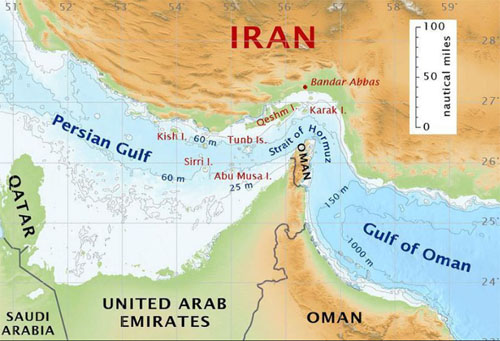by WorldTribune Staff, May 17, 2019
U.S. intelligence agencies believe Iran-backed terror proxies, or those sympathetic to Iran, are behind the attacks on four oil tankers off the coast of the United Arab Emirates.
Reuters reported that a U.S. government source said American security analysts believe Iran gave its “blessing” to tanker attacks which hit two Saudi crude oil tankers, a UAE-flagged fuel bunker barge and a Norwegian-registered oil products tanker off Fujeirah near the Strait of Hormuz.
 UAE Foreign Minister Anwar Gargash on May 15 said that “Iranian behavior” was at the center of problems in the Persian Gulf region.
UAE Foreign Minister Anwar Gargash on May 15 said that “Iranian behavior” was at the center of problems in the Persian Gulf region.
“We have been bullied by Iran. We have seen aggressive Iranian action in the region,” Gargash said.
Related: Khamenei decides: Iran will confront the U.S. and its allies, May 16, 2019
Gargash added that “we need to emphasize caution and good judgment. It is easy to throw accusations, but it is a difficult situation.”
Saudi Energy Minister Khalid al-Falih said the May 12 attack on Saudi vessels did not cause any casualties or an oil spill but led to significant damage to the structures of the two vessels.
Iran has denied it was involved in the attack on the vessels.
“The operation near the Strait of Hormuz appeared designed to test the resolve of the United States and its Sunni Muslim allies without triggering a war, after Washington tightened sanctions on Iran and beefed up its military presence nearby,” Radio Free Europe/Radio Liberty said in a May 16 report.
“This is a pin-prick event, a little needle-like jab at the maritime trade going into the Strait of Hormuz,” said Gerry Northwood, chairman of risk management and security firm MAST.
The Strait of Hormuz is a narrow waterway separating Iran from the Arabian Peninsula where a fifth of global oil supplies pass from Middle East producers.
The U.S. Navy’s Bahrain-based Fifth Fleet is tasked with protecting commercial ships in the area. The British and French navies maintain a presence, while Saudi Arabia and the UAE have high-tech naval capacities.
Gulf Arab states are said to be struggling to build an effective system to defend against drones and low-tech sabotage attempts in the region.
“There are hundreds, if not a few thousand, small boats moving in that area every day. Many of these vessels are smugglers operating between Iran and the Gulf states,” said Norman Roule, a retired senior U.S. intelligence officer. “This will make it difficult, but not impossible, to trace any small vessels which may have been involved in the operation.”
Meanwhile, the Iran-backed Houthi rebels in Yemen carried out a drone strike this week on a critical Saudi oil pipeline.
On May 14, the Houthis say they launched seven drones to target Saudi Arabia. The drones struck pumping stations along the kingdom’s crucial East-West Pipeline, causing minor damage, Saudi officials say.
United Nations investigators said the Houthis’ new UAV-X drone, found in recent months during the Saudi-led coalition’s war in Yemen, likely has a range of up to 1,500 kilometers (930 miles).
That puts the far reaches of both Saudi Arabia and the UAE, the two main opponents of the Houthis, within reach of drones difficult to detect and track.
Your Intel Brief: Geostrategy-Direct __________ Fix The Media Now
